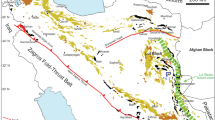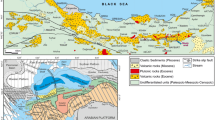Abstract
Late Carboniferous (300–290 Ma) calc-alkaline basalts, andesites, and rhyolites typical of volcanic arc settings occur in the intermontane Saar-Nahe basin (SW Germany) within the Variscan orogenic belt. The volcanic rock suite was emplaced under a regime of tensional tectonics during orogenic collapse and its origin has been explained by melting of mantle and crust in the course of limited lithospheric rifting. We report major, trace and rare-earth-element data (REE), and Nd-Pb-Sr-O isotope ratios for a representative sample suite, which are fully consistent with an origin closely related to plate subduction. Major and trace element data define continuous melt differentiation trends from a precursor basaltic magma involving fractional crystallization of olivine, pyroxene, plagioclase, and magnetite typical of magma evolution in a volcanic arc. This finding precludes an origin of the andesitic compositions by mixing of mafic and felsic melts as can be expected in anorogenic settings. The mafic samples have high Mg numbers (Mg# = 65–73), and high Cr (up to 330 ppm) and Ni (up to 200 ppm) contents indicating derivation from a primitive parental melt that was formed in equilibrium with mantle peridotite. We interpret the geochemical characteristics of the near-primary basalts as reflecting their mantle source. The volcanic rocks are characterized by enrichment in the large ion lithophile elements (LILE), negative Nb and Ti, and positive Pb anomalies relative to the neighboring REE, suggesting melting of a subduction-modified mantle. Initial Nd values of −0.7 to −4.6, Pb, and 87Sr/86Sr(t) isotope ratios for mafic and felsic volcanics are similar and indicate partial melting of an isotopically heterogeneous and enriched mantle reservoir. The enrichment in incompatible trace elements and radiogenic isotopes of a precursor depleted mantle may be attributed to addition of an old sedimentary component. The geochemical characteristics of the Saar-Nahe volcanic rocks are distinct from typical post-collisional rock suites and they may be interpreted as geochemical evidence for ongoing plate subduction at the margin of the Variscan orogenic belt not obvious from the regional geologic context.
Similar content being viewed by others
Author information
Authors and Affiliations
Additional information
Received: 3 August 1998 / Accepted: 2 January 1999
Rights and permissions
About this article
Cite this article
Schmidberger, S., Hegner, E. Geochemistry and isotope systematics of calc-alkaline volcanic rocks from the Saar-Nahe basin (SW Germany) – implications for Late-Variscan orogenic development. Contrib Mineral Petrol 135, 373–385 (1999). https://doi.org/10.1007/s004100050518
Published:
Issue Date:
DOI: https://doi.org/10.1007/s004100050518




